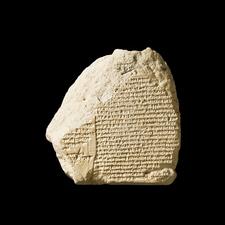“The handwriting is on the wall.”
The next time you hear someone use that phrase, ask them where it comes from. Many people have no idea it comes from the Book of Daniel.
“In the same hour the fingers of a man’s hand appeared and wrote opposite the lampstand on the plaster of the wall of the king’s palace; and the king saw the part of the hand that wrote … Then the fingers of the hand were sent from Him, and this writing was written. And this is the inscription that was written: MENE, MENE, TEKEL, UPHARSIN.” Daniel 5:5, 24-25
In the last part of our study about archeology and the Book of Daniel, we saw the evidence supporting the historical claim that Belshazzar ruled as a co-regent from Babylon. The “handwriting on the wall” concerns the last night of Belshazzar’s rule and the first days of the Persians conquering Babylon. Does archeology support the details listed in Daniel? If so, what does that mean?
Ancient Histories
The Persian defeat of Babylon is well-documented. The Greek historian Herodotus wrote during the 5th century BC that the Babylonians fought the Persians for a short time outside the city of Babylon before retreating back into the city.
“So when in his advance he came near to the city, the Babylonians joined battle with him, and having been worsted in the fight they were shut up close within their city. But knowing well even before this that Cyrus was not apt to remain still, and seeing him lay hands on every nation equally, they had brought in provisions beforehand for very many years. So while these made no account of the siege, Cyrus was in straits what to do, for much time went by and his affairs made no progress onwards.” Herodotus, Histories 1:190
Herodotus wrote that the Persian soldiers took the city by surprise because “they chanced to be holding a festival, they went on dancing and rejoicing during this time until they learnt the truth only too well.” (Herodotus, Histories 1:191)
The Persian historian Xenophon (5th century BC) also wrote about the festival “during which all Babylon was accustomed to drink and revel all night long.” (Cyropaedia of Xenophon; The Life of Cyrus the Great, 7.5.15)
We learn more about that festival in the Book of Daniel.
“Belshazzar the king made a great feast for a thousand of his lords, and drank wine in the presence of the thousand. While he tasted the wine, Belshazzar gave the command to bring the gold and silver vessels which his father Nebuchadnezzar had taken from the temple which had been in Jerusalem, that the king and his lords, his wives, and his concubines might drink from them. Then they brought the gold vessels that had been taken from the temple of the house of God which had been in Jerusalem; and the king and his lords, his wives, and his concubines drank from them. They drank wine, and praised the gods of gold and silver, bronze and iron, wood and stone.” Daniel 5:1-4

Courtesy British Museum
The Babylonians had just suffered defeat outside the city of Babylon at the hands of the Persians. Why would they be celebrating? It may have been Belshazzar’s way of boosting morale among those who would be involved in helping him lead the people of Babylon during what could have been a long siege. The Nabonidus Chronicle (6th century BC) related that Nabonidus, Belshazzar’s father, fled from the Persians days before the army entered Babylon. Another possibility is that Belshazzar used the festival as his own coronation as sole regent after he heard what had happened to Nabonidus. Yet another possibility might be that the Babylonians were observing an annual feast that happened to fall on that date and the Persian soldier took advantage of the leaders and people partying and not paying as much attention to the security of their city.
Babylonian King Nebuchadnezzar brought the gold vessels from the Jerusalem Temple to Babylon many years decades earlier and housed them in a pagan temple treasury (details about what was taken found in 2 Kings 25:13-17). Why did Belshazzar have the sacred vessels brought to the banquet? It may have been his attempt to demonstrate the superiority of the Babylonian gods to all other gods, including the Hebrew God. Whatever Belshazzar’s reason, it did not end well for him or the people with him.
“In the same hour the fingers of a man’s hand appeared and wrote opposite the lampstand on the plaster of the wall of the king’s palace; and the king saw the part of the hand that wrote. Then the king’s countenance changed, and his thoughts troubled him, so that the joints of his hips were loosened and his knees knocked against each other. The king cried aloud to bring in the astrologers, the Chaldeans, and the soothsayers. The king spoke, saying to the wise men of Babylon, ‘Whoever reads this writing, and tells me its interpretation, shall be clothed with purple and have a chain of gold around his neck; and he shall be the third ruler in the kingdom.’Now all the king’s wise men came, but they could not read the writing, or make known to the king its interpretation. Then King Belshazzar was greatly troubled, his countenance was changed, and his lords were astonished. The queen, because of the words of the king and his lords, came to the banquet hall. The queen spoke, saying, ‘O king, live forever! Do not let your thoughts trouble you, nor let your countenance change. There is a man in your kingdom in whom is the Spirit of the Holy God. And in the days of your father, light and understanding and wisdom, like the wisdom of the gods, were found in him; and King Nebuchadnezzar your father—your father the king—made him chief of the magicians, astrologers, Chaldeans, and soothsayers. Inasmuch as an excellent spirit, knowledge, understanding, interpreting dreams, solving riddles, and explaining enigmas were found in this Daniel, whom the king named Belteshazzar, now let Daniel be called, and he will give the interpretation.” Daniel 5:5-12
Herodotus recorded the name of the ‘queen’ who told Belshazzar about Daniel as ‘Nitocris’ (Herodotus, Histories 1:185-188). She may have been the daughter of Nebuchadnezzar, wife of Nabonidus and mother of Belshazzar. Herodotus recorded how Nitocris directed workers to alter the flow of the river Euphrates ‘so that the Medes might not have dealings with her kingdom and learn of her affairs (Herodotus, Histories 1:185-186). Herodotus also recorded how the Medes-Persians were able to overcome Queen Nitocris’ defenses, enter the city of Babylon and defeat the Babylonians while they were dancing and rejoicing while holding a festival in the city (Herodotus, Histories 1:190-191) – possibly the same festival described in Daniel 5.
The ‘queen’ told Belshazzar about a man that King Nebuchadnezzar had made ‘chief of the magicians, astrologers, Chaldeans, and soothsayers.’ That man was Daniel. The queen strongly recommended that Belshazzar call for Daniel to come and ‘give the interpretation’ to the writing on the wall.
Daniel did come to the festival and told Belshazzar that God sent the fingers of the hand writing on the wall because Belshazzar had lifted himself ‘up against the Lord of heaven’ (Daniel 5:23). Daniel interpreted the words on the wall – MENE, MENE, TEKEL, UPHARSIN – as ‘God has numbered your kingdom, and finished it … You have been weighed in the balances, and found wanting … Your kingdom has been divided, and given to the Medes and Persians’ (Daniel 5:26-28). Belshazzar then gave the command that Daniel be clothed with purple along with a chain of gold around his neck, and that a proclamation be made about Daniel becoming the ‘third ruler in the kingdom’ (Daniel 5:29). As we’ve seen earlier, Belshazzar would have been the second ruler in the kingdom after his father, Nabonidus, so the highest position Belshazzar could have given Daniel was third ruler in the kingdom.
Darius or Cyrus?
“That very night Belshazzar, king of the Chaldeans, was slain. And Darius the Mede received the kingdom, being about sixty-two years old.” Daniel 5:30-31
Daniel wrote that Darius the Mede received the Kingdom of Babylon, but Herodotus wrote that Cyrus received it. Which one is correct? In the next edition of ‘Convince Me There’s A God’ we will see what archeology tells us about that as well as what Cyrus did for the Jews living in Babylon.
Scripture taken from the New King James Version®. Copyright © 1982 by Thomas Nelson. Used by permission. All rights reserved.

 “The handwriting is on the wall.”
“The handwriting is on the wall.”